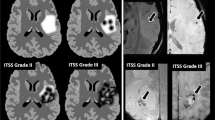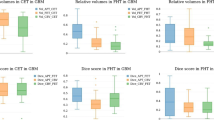Abstract
Introduction
SWI can help to identify high-grade gliomas (HGG). The objective of this study was to analyse SWI and CE-SWI characteristics, i.e. the relationship between contrast-induced phase shifts (CIPS) and intratumoral susceptibility signals (ITSS) and their association with tumour volume in patients with glioblastoma multiforme (GBM).
Materials and methods
MRI studies of 29 patients were performed to evaluate distinct susceptibility signals comparing SWI and CE-SWI characteristics. The relationship between these susceptibility signals and CE-T1w tumour volume was analysed by using Spearman’s rank correlation coefficient and Kruskal-Wallis-test. Tumour biopsies of different susceptibility signals were performed in one patient.
Results
Comparison of SWI and CE-SWI demonstrated different susceptibility signals. Susceptibility signals visible on SWI images are consistent with ITSS; those only seen on CE-SWI were identified as CIPS. Correlation with CE-T1w tumour volume revealed that CIPS were especially present in small or medium-sized GBM (Spearman’s rho r = 0.843, P < 0.001). Histology identified the area with CIPS as the tumour invasion zone, while the area with ITSS represented micro-haemorrhage, highly pathological vessels and necrosis.
Conclusion
CE-SWI adds information to the evaluation of GBM before therapy. It might have the potential to non-invasively identify the tumour invasion zone as demonstrated by biopsies in one case.
Key Points
• MRI is used to help differentiate between low- and high-grade gliomas.
• Contrast-enhanced susceptibility-weighted MRI (CE-SWI) helps to identify patients with glioblastoma multiforme.
• CE-SWI delineates the susceptibility signal (CIPS and ITSS) more than the native SWI.
• CE-SWI might have the potential to non-invasively identify the tumour invasion zone.








Similar content being viewed by others
Abbreviations
- CE-SWI:
-
Contrast-enhanced susceptibility weighted imaging
- FLAIR:
-
Fluid-attenuated inversion recovery pulse sequence
- HGG:
-
High-grade glioma
- ITSS:
-
Intratumoral susceptibility signals
- LGG:
-
Low-grade glioma
- MRI:
-
Magnetic resonance imaging
- CIPS:
-
Contrast-induced phase shifts
- SWI:
-
Susceptibility-weighted imaging
- CE-T1 WI:
-
Contrast-enhanced T1-weighted imaging
References
Rauscher A, Sedlacik J, Deistung A, Mentzel HJ, Reichenbach JR (2006) Susceptibility weighted imaging: data acquisition, image reconstruction and clinical applications. Z Med Phys 16:240–250
Haacke EM, Mittal S, Wu Z, Neelavalli J, Cheng YC (2009) Susceptibility-weighted imaging: technical aspects and clinical applications, part 1. AJNR Am J Neuroradiol 30:19–30
Haacke EM, Xu Y, Cheng YC, Reichenbach JR (2004) Susceptibility weighted imaging (SWI). Magn Reson Med 52:612–618
Barnes SR, Haacke EM (2009) Susceptibility-weighted imaging: clinical angiographic applications. Magn Reson Imaging Clin N Am 17:47–61
Haacke EM, DelProposto ZS, Chaturvedi S et al (2007) Imaging cerebral amyloid angiopathy with susceptibility-weighted imaging. AJNR Am J Neuroradiol 28:316–317
Mittal S, Wu Z, Neelavalli J, Haacke EM (2009) Susceptibility-weighted imaging: technical aspects and clinical applications, part 2. AJNR Am J Neuroradiol 30:232–252
Sehgal V, Delproposto Z, Haacke EM et al (2005) Clinical applications of neuroimaging with susceptibility-weighted imaging. J Magn Reson Imaging 22:439–450
El-Koussy M, Schenk P, Kiefer C et al (2012) Susceptibility-weighted imaging of the brain: does gadolinium administration matter? Eur J Radiol 81:272–276
Sehgal V, Delproposto Z, Haddar D et al (2006) Susceptibility-weighted imaging to visualize blood products and improve tumor contrast in the study of brain masses. J Magn Reson Imaging 24:41–51
Kim HS, Jahng GH, Ryu CW, Kim SY (2009) Added value and diagnostic performance of intratumoral susceptibility signals in the differential diagnosis of solitary enhancing brain lesions: preliminary study. AJNR Am J Neuroradiol 30:1574–1579
Li C, Ai B, Li Y, Qi H, Wu L (2009) Susceptibility-weighted imaging in grading brain astrocytomas. Eur J Radiol 75:e81–e85
Park MJ, Kim HS, Jahng GH, Ryu CW, Park SM, Kim SY (2009) Semiquantitative assessment of intratumoral susceptibility signals using non-contrast-enhanced high-field high-resolution susceptibility-weighted imaging in patients with gliomas: comparison with MR perfusion imaging. AJNR Am J Neuroradiol 30:1402–1408
Pinker K, Noebauer-Huhmann IM, Stavrou I et al (2007) High-resolution contrast-enhanced, susceptibility-weighted MR imaging at 3T in patients with brain tumors: correlation with positron-emission tomography and histopathologic findings. AJNR Am J Neuroradiol 28:1280–1286
Hori M, Ishigame K, Kabasawa H et al (2010) Precontrast and postcontrast susceptibility-weighted imaging in the assessment of intracranial brain neoplasms at 1.5 T. Jpn J Radiol 28:299–304
Brokinkel B, Fischer BR, Peetz-Dienhart S et al (2010) MGMT promoter methylation status in anaplastic meningiomas. J Neurooncol 100:489–490
Liu G, Sobering G, Duyn J, Moonen CT (1993) A functional MRI technique combining principles of echo-shifting with a train of observations (PRESTO). Magn Reson Med 30:764–768
Pichlmeier U, Bink A, Schackert G, Stummer W (2008) Resection and survival in glioblastoma multiforme: an RTOG recursive partitioning analysis of ALA study patients. Neuro Oncol 10:1025–1034
Pedraza S, Puig J, Blasco G et al (2012) Reliability of the ABC/2 method in determining acute infarct volume. J Neuroimaging 22:155–159
Barth M, Nobauer-Huhmann IM, Reichenbach JR et al (2003) High-resolution three-dimensional contrast-enhanced blood oxygenation level-dependent magnetic resonance venography of brain tumors at 3 Tesla: first clinical experience and comparison with 1.5 Tesla. Invest Radiol 38:409–414
Holash J, Maisonpierre PC, Compton D et al (1999) Vessel cooption, regression, and growth in tumors mediated by angiopoietins and VEGF. Science 284:1994–1998
Holash J, Wiegand SJ, Yancopoulos GD (1999) New model of tumor angiogenesis: dynamic balance between vessel regression and growth mediated by angiopoietins and VEGF. Oncogene 18:5356–5362
Matsukado Y, Maccarty CS, Kernohan JW (1961) The growth of glioblastoma multiforme (astrocytomas, grades 3 and 4) in neurosurgical practice. J Neurosurg 18:636–644
Sampetrean O, Saga I, Nakanishi M et al (2011) Invasion precedes tumor mass formation in a malignant brain tumor model of genetically modified neural stem cells. Neoplasia 13:784–791
Wu Z, Mittal S, Kish K, Yu Y, Hu J, Haacke EM (2009) Identification of calcification with MRI using susceptibility-weighted imaging: a case study. J Magn Reson Imaging 29:177–182
Zhu WZ, Qi JP, Zhan CJ et al (2008) Magnetic resonance susceptibility weighted imaging in detecting intracranial calcification and hemorrhage. Chin Med J (Engl) 121:2021–2025
Al Sayyari A, Buckley R, McHenery C, Pannek K, Coulthard A, Rose S (2010) Distinguishing recurrent primary brain tumor from radiation injury: a preliminary study using a susceptibility-weighted MR imaging-guided apparent diffusion coefficient analysis strategy. AJNR Am J Neuroradiol 31:1049–1054
Lupo JM, Chuang CF, Chang SM et al (2012) 7-Tesla susceptibility-weighted imaging to assess the effects of radiotherapy on normal-appearing brain in patients with glioma. Int J Radiat Oncol Biol Phys 82:e493–e500
Author information
Authors and Affiliations
Corresponding author
Rights and permissions
About this article
Cite this article
Fahrendorf, D., Schwindt, W., Wölfer, J. et al. Benefits of contrast-enhanced SWI in patients with glioblastoma multiforme. Eur Radiol 23, 2868–2879 (2013). https://doi.org/10.1007/s00330-013-2895-x
Received:
Accepted:
Published:
Issue Date:
DOI: https://doi.org/10.1007/s00330-013-2895-x




